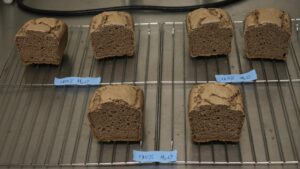Exceptional inventors from Denmark, France, Germany, the Netherlands and the UK receive the 2016 European Inventor Award and Italian scientists are among the finalists for viable alternatives to wheat dough.
During a recent ceremony in Lisbon on 9 June, the European Patent Office (EPO) showcased the best and brightest in innovation with the European Inventor Award. This award is now in its 11th year, and is presented annually by the EPO to recognise outstanding inventors from Europe and around the world, who have made an exceptional contribution to technological progress, social development and economic growth. The ceremony was attended by nearly 600 participants from the areas of politics, business, intellectual property and science, including António Costa, Portugal’s prime minister, and Carlos Moedas, the European commissioner for research, science and innovation.
‘Today’s award ceremony is a tribute to the spirit of innovation and the work of dedicated individuals who, through their inventions, advance the state of the art for all of us’, said Benoît Battistelli, EPO’s president. ‘The inventions recognised with this year’s award give new hope to people suffering from disease, increase diagnostic efficiency, protect the environment and save thousands of lives on the road. The significance and impact of the work of these inventors underline the importance of the European patent system for the benefit of economic strength and technological progress in Europe’, said Battistelli.
Leading up to the ceremony, an independent international jury selected the 15 finalists—three in each of the five award categories—from more than 400 proposals. To qualify for the award, the proposals had to meet specific criteria, including the inventor having been granted at least one European patent for his or her invention by the EPO. The nomination titled, ‘Gluten Substitutes from Corn’ caught the eye of European Seed.
Viable Alternatives to Wheat Dough
Italian scientists Virna Cerne and Ombretta Polenghi and their team at Dr. Schär in Italy are at the forefront of gluten-free baked goods development, producing an array of pastas and baked goods which allow people with gluten intolerance to enjoy a versatile and tasty diet without compromising their dietary restrictions. The unique selling point of the company’s food products is the quality of the dough used to make them.
In an age of social media and celebrity diets, going gluten-free is practically ‘en vogue’. Legions of wellness-focused foodies swear by their avoidance of proteins found in wheat and other grains, and events are held to promote all kinds of gluten-free products. But for about one per cent of the world’s population, avoiding gluten is not a lifestyle choice—it’s a means of avoiding the agonising side effects of coeliac disease. The fact is, it’s hard to find a viable alternative for wheat dough, which has its own unique chemical behaviour, taste and texture. A simple substitution is not always possible. In 2013, Cerne and Polenghi patented a method for extracting gluten-like proteins (called zein) from corn, and adding them to recipes. The result is a protein supplement that offers the taste and texture of wheat products but lowers the price point, so it can be enjoyed by a wider segment of the population.
Societal Benefit
Coeliac disease is an autoimmune disorder in which gluten damages the fine, bristly inner surface of the small intestine. Since one of the primary functions of the small intestine is to absorb nutrients from food into the bloodstream, coeliac patients often suffer from chronic fatigue, vitamin deficiencies and anaemia. For these people, a strict gluten-free diet remains the only effective treatment against their condition. However, avoiding gluten isn’t always easy, or pleasant. For people with dietary restrictions who still like to eat well, Cerne and Polenghi’s process for extracting protein from corn is a godsend—and a delicious one at that.
About one per cent of the world’s population is estimated to suffer from coeliac disease. Incidence rates for adults vary across European nations. At the low end, only about 0.3 per cent of Germans (240,000) are affected, but near the top of the list are Finns, of whom around 2.4 per cent have the condition (120,000). An estimated three million Americans—one in 133—show symptoms of the disease. These numbers are likely to increase with awareness: the condition is considered vastly under- and misdiagnosed.
In addition to those with coeliac disease, a growing number of people also report suffering from what is called a gluten intolerance or sensitivity. They express similar symptoms, which vary in severity when they consume grain products. The incidence of gluten intolerance is estimated to occur at a rate six times that of true coeliac disease.
Economic Benefit
Around the world, people who lived gluten-free in 2015 supported a market worth an estimated €4.27 billion. However, they weren’t only spending their money on alternative breads and pastas. Travellers were booking gluten-free vacations, while health-conscious apps were pointing the hungry to gluten-free restaurants and suggesting the newest delicious recipes.
Gluten-free soap? No problem. Gluten-free dog food? Yes, even that. New products are being created every day, it seems—which is why sales of gluten-free products are expected to reach €7 billion by 2020. Meanwhile in Trieste, Italy, where Dr. Schär’s R&D operations are based, new ingredients and processes—from cultivation techniques to sensor technologies—are being explored. That’s how the company, which employs more than 1,070 people, plans to defend its market share—some 35 to 40 per cent of the European gluten-free market—and increase its annual turnover, which currently totals €320 million.
European Inventor Award
The European Inventor Award, now in its 11th year, is one of Europe’s most prestigious innovation prizes. Launched by the European Patent Office in 2006, the annual award distinguishes individual inventors and teams of inventors whose pioneering inventions provide answers to some of the biggest challenges of our times. The winners are selected by an independent jury consisting of international authorities in the fields of business, science, academia and research, who examine the proposals in terms of their contribution toward technical progress, social development, and wealth and job creation in Europe. The general public also takes part in conferring the award: the winner of the Popular Prize is chosen from among the 15 finalists by online voting.
2016 European Inventor Award Winners
Industry
Bernhard Gleich, Jürgen Weizenecker
and team (Germany)
Germany physicists Bernhard Gleich and Jürgen Weizenecker and their team received the award in the industry category for laying the foundation of a new category of medical imaging solutions. Developed in the laboratory of Philips Research Hamburg, magnetic particle imaging offers real-time images of body tissues in unprecedented quality. Their magnet-based imaging method, currently in pre-clinical evaluation, promises to enable doctors to obtain instant 3D images of tissue complications, including cancers and vascular diseases.
Small and Medium-Sized Enterprises (SMEs)
Tue Johannessen, Ulrich Quaade, Claus Hviid Christensen
and Jens Kehlet Nørskov (Denmark)
The Danish research team received the award in the SME category for the groundbreaking application of ammonia in solid form to reduce air pollution from diesel engines and act as an emissions-free fuel. Released into the exhaust system of diesel engines, it can reduce the amount of harmful emitted NOx (mono-nitrogen oxides; a key component of smog) by up to 99 per cent. Theirs is a true start-up success story powered by patented inventions.
Research
Alim-Louis Benabid (France)
French physicist and neurosurgeon Alim-Louis Benabid was honoured for revolutionising the treatment of Parkinson’s disease and other neurological conditions with the use of high-frequency deep brain stimulation. Based on controlled electric charges administered via a probe implanted into the patient’s skull—akin to a ‘brain pacemaker’—Benabid’s method has become a standard treatment around the world, and has benefited more than 150,000 people, who can now lead self-directed, independent lives thanks to the invention.
Non-European Countries
Robert Langer (United States)
U.S. chemical engineer Robert Langer received the award in the lifetime achievement category for the groundbreaking invention of biodegradable plastics that encapsulate powerful anti-cancer drugs for a new level of targeted delivery. Langer’s bioplastics can be shaped into ‘wafers’ filled with cancer-starving drugs, implanted right above the sites of tumours where natural degradation releases the drug for maximum efficacy. Langer’s patented inventions have been licensed to more than 300 pharmaceutical companies and have already benefited more than one million people worldwide. The prolific inventor heads a team of more than 100 researchers at the Massachusetts Institute of Technology.
Lifetime Achievement
Anton van Zanten (Germany/Netherlands)
Engineer Anton van Zanten was honoured for his landmark contributions to automotive safety systems, which have saved thousands of lives and are now mandatory features in new automobiles. Throughout an automotive engineering career with German company Robert Bosch spanning more than 40 years, van Zanten pioneered the electronic stability control system and other solutions to prevent automobiles from veering off the road and crashing in extreme braking situations.
Popular Prize
Helen Lee (UK/France)
Cambridge University researcher Helen Lee was picked by an overwhelming majority of the public to receive the Popular Prize Award for her invention of diagnostic kits for resource-poor regions of the globe. Already used to test more than 40,000 people, her robust, instant blood diagnostic kits are cost-effective and easy to use for detection of infectious diseases such as HIV, hepatitis B and chlamydia. Lee received more than 36,300 votes, or 64 per cent, of the total record number of 56,700 votes cast online by the public in the five weeks leading up to the award ceremony (up from 46,800 total votes last year). This was by far the highest number of public votes ever received by any European Inventor Award finalist since the launch of the popular prize category in 2013.













